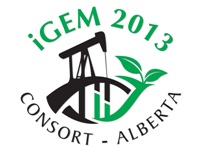Team:Consort Alberta
From 2013hs.igem.org
Consort Alberta iGEM 2013
Eleven students and two supervisors make up the Consort iGEM team. We are located in Consort, Alberta and attend the local K-12 school which has 232 students overall, with around 70 people in the high school. This is our very first year in iGEM and, being in the middle of nowhere, three and a half hours away from the nearest city with a bio chemistry lab. It has been challenging to get the supplies we need. We not only took on the challenge of genetically engineering E.Coli, but we took on the challenges of developing our very own biochemistry lab in the high school science lab, designing the bio brick, teaching ourselves HTML coding, and most importantly teaching our community about synthetic biology. The iGem project has been a great experience for all of us, and we cannot wait to participate in the coming years when we will have the equipment and the experience to focus more on the science than we were able to this year.
The aim of this year’s Consort high-school iGEM project is to engineer a bacterial strain which can be used to test for xylene levels in soil samples. We live in a rural area and our economy is based on agriculture and fossil fuel production. The presence of certain hydrocarbon compounds can pose health and safety risks if they enter the food chain or if people exceed safe exposure limits. Oil and gas wells are routinely drilled on leases, small portions of fields used for agricultural production. Oil is usually trucked from these sites to collection centres where it is processed. Every time the oil is transferred there is an opportunity for some spillage to occur. Not all spills, however, are equally dangerous and differentiating between more and less dangerous spills is important in reacting to them appropriately. Additionally the extent or the presence of a dangerous spill is often uncertain. Our project would, in principle, allow anyone to easily and quickly answer all the queries above. Early identification of contamination will facilitate rapid clean-up and minimize health risks to members of our community and to the consumers who rely on the food we produce.

 "
"
